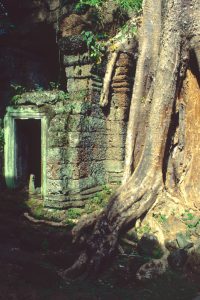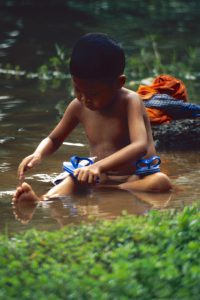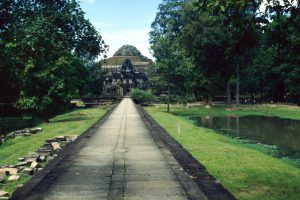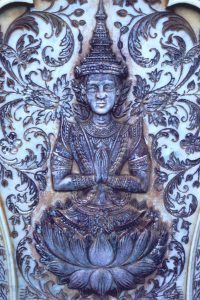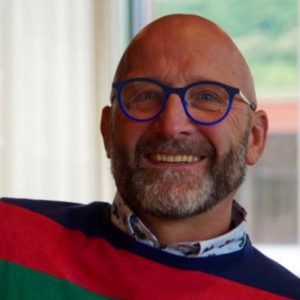Cambodia, not to long ago the stage for an awful war with inhuman cruelties, is now quickly recovering and making itself up for a better future. Because of the war and the unstable period after that Cambodia has been long off the travelers world map, in spite of an enormous rich cultural heritage patiently waiting to be rediscovered. After many years the time seemed to be right to go so not surprisingly it was the first stop from Silvia, my Swiss travel partner who I met the previous year in Myanmar (Burma), and myself on our trip to Indochina.

Our discovery started in Siem Reap after an 18 hour long journey from Amsterdam via Kopenhagen and Bangkok. Until the very last moment we did know whether we would be able to fulfill our plans or not. Continuing rainfall and severe flooding all over Cambodia, Laos and Vietnam seemed to put a spell on our plans and made it all very uncertain. The last half hour of our flight we could see enormous masses of flooded land but after touchdown the sun was shining as a warm welcome to us and soon we found out that the area’s we wanted to visit were not affected by the flooding. We really counted ourselves lucky. In total we had 3 days to get a glimpse of the impressive remains of the Angkor period.
After 2 hours of sleep to recover from the long flight both Silvia and I were feeling totally refreshed again and were ready to hit the road, ready for our discovery. As Angkor Wat had been on my “much wanted” list for a long time I was really excited when we arrived at the site.
It is impossible to describe the enormous beauty and size of Angkor Wat. Describing it over here would only make people think I’m exaggerating but it is surely one of the most beautiful temples I have seen so far in South East Asia. The size, the beauty and the symbolism behind the architecture was enormous. Not strange that we spent the whole afternoon over there.
On our second day in Cambodia we had some more sites on our itinerary. Our taxi was replaced by a 4 wheel drive and we started our journey to Banteay Srei, one of the more remote temples. The road was bad but we had hardly time to keep attention for that since the landscape was totally amazing. Until recently it was impossible to visit Banteay Srei, which is dedicated to Shiva, because of Khmer activity in the region. It is one of the smallest temples in the area but the carvings are exquisite.
On our way back we visited Banta Samre which was built in the 12th century. We met a group of friendly people in the area who were picnicking. The temple itself was pretty nice and we had some nice encounters with local children who showed great interest in our cameras.
After a fantastic lunch we headed on to Tha Prom, one of the Buddhist temples in the area. Tha Prom is spectacular as it is one of the few which is left over to the jungle like how it was found when the Angkor temples were rediscovered in 1860 by a French expedition. It was amazing how the jungle had taken control over the site and the roots from giant trees crawled around the temple walls like a blanket. I must admit I felt a bit like Indiana Jones wandering through this place.
Our next stop was Tha Keo, the first Angkor monument which was totally built out of sandstone. Compared to the other monuments it had a bit of a spartan touch since the decorations have never been finished. Still not having enough we continued to the Thommanon. This temple was dedicated to Shiva and Vishnu and most likely built in the 2nd half of the 12th century. It was a worthy ending of an impressive day.
The 26th of September was already our last day in Siem Reap, it seemed we could stay here much longer but there were still other places to be visited. We kicked off the day with a visit to Angkor Thom, which is most likely the largest city from the classic age. It is believed that over a million people lived over here on an area of 10 square kilometers. The first impression we got was one of the 5 gates through which we entered the remains of the city. It was here that we saw one of the famous carved smiling faces.
Exactly in the middle of Angkor Tom the Bayon temple was built. It had 3 levels, small corridors and steep stairs connecting the different levels. We already noticed them as soon as we approached the temple but once on the top level we were totally overwhelmed by the 200 smiling faces of Avalokiteshhvara which decorated the 54 gothic towers. It was in one word marvelous, Neither Silvia or myself had seen anything like this before on our previous travels. Smiles were coming from every direction and everywhere we looked.
Our next stop was at the terrace of elephants. from there we walked to the Baphuon, a pyramid shaped temple which represents thy mythical mount Meru. The Baphuon was built in the centre of the old city Nagarajayacri, the spot where later on the city Angor Tom was built. We slowly strolled on and entered the remains of the Royal palace through one of the side gates. Not much was to be seen over there, except 2 large pools and the Phimeanakas temple which originally had a gilded top.
Just outside the royal palace we found the Preah Palilay temple which is neglected by a lot of people although it’s a picturesque place in a beautiful surrounding. We closed the circle at the terrace of leper king which is one of Angkor’s mysteries. It is seven meters high and lies to the north of the terrace of elephants. Nobody knows exactly it’s purpose but it is believed that is was used as a royal cremation place.
Our discovery seemed to have no end and already full of impressions we arrived at Preah Khan, the temple of the holy swords. Dedicated to no less then 515 saints 18 major festivals took place at this place in one year. The size, 700 by 800 meters was immense and most likely it was the residence of king Jayavarman VII during the construction of Angkor Thom.
Like Tha Prom it was left to the jungle and we were lucky that a friendly policemen offered to guide us around the place in exchange for practicing his English. He showed us spots we would never have found ourselves.
We ended our visit to the Angkor to region where we started, we just had to return to Angkor Wat to enjoy a bit more of its magnificence. This time we sat on one of the terraces of the upper level and breathed it’s atmosphere.
In the evening the owners of our guest house showed the movie “the killing fields” and as Silvia hadn’t seen it before we stayed to watch it. Not only is it one of my favorite movies (for me the movie is about friendship and not war), also it was a good way to prepare for the things to come. As usual I had tears in my eyes at the end of the film, this time it was even more intense since we were now in Cambodia ourselves.
The next morning we had to rise early since we had to catch a flight to Phnom Penh. At the airport we found out that our flight was canceled, no stress though, we were simply booked on the next flight, one hour later. In Phnom Penh we checked in at our guesthouse. Then we took two motorbike taxis to Eurasie Phnom Penh Travel, the travel agency who took care of booking our continuing flight to Laos after I contacted them by e-mail. After that business was completed our motor drivers took us on a tour to some of the landmarks in the area.
The first stop was S-21, nowadays known as the Tuol Sleng museum. Over here 20.000 people have been tortured and killed between 1975 and 1978 during the regime of Pol Pot’s Khmer Rouge. Needless to say the sights were horrible. The whole place was a silent witness of a terrible time.
Remains and pictures from the Khmer Rouge genocide impressed us deeply and our stomachs turned round on several occasions… “Don’t let shit like this ever happen again. Please!” was written on one of the walls of the former destruction camp, it could not have expressed my feelings better.
Silvia and I did not speak much during our ride to the Killing fields of Choeung Ek, which was our next stop. Over here we witnessed more prove of the horror that overcame Cambodia during the Khmer Rouge regime. Though the place was located in a beautiful surrounding the terror could still be felt.
Holes in the ground showed the places where over 17.000 men, women and children were buried in mass graves after they were brutally murdered. 8985 of them found their last resting place in the memorial stupa which was erected in the middle of the fields.
It was good to see the other side of the mirror and look at the remains of a period which is even not that far back in Cambodia’s tumulus past. However, both Silvia and I were happy that this part was over and we could now focus again on the much more joyful present. On the way back to Phnom Penh we visited a beautiful pagoda where we had some nice encounters with some local children. They were extremely spontaneous and friendly and seemed not aware of the terrifying time their parents experienced. This is the Cambodia I would like to keep in memory.
Our next stop was a local market called Psar Tuol Ton Pong. The major part was inside a large building where shoes, clothes, housekeeping tools, food and other stuff for daily use were sold. For us the most interesting area was outside though were meat, vegetables and flowers were presented by friendly saleswomen. The atmosphere was like at every Asian market place, great! It would have been easy to spend hours over here but we had still more places on our program.
Back in the center of Phnom Penh we visited Wat Bodum, the temple of the lotus flower. Loads of stupas were build on it’s premises and we really enjoyed our stay over here.
It was not a long ride to the Royal Palace. Built in a beautiful garden we could see the major part of the palace which was built in typical Khmer style. The highlight of our visit was the beautiful silver pagoda which got his name from the 5000 silver tiles which cover the floor. Now it is a museum which gives a good impression of the religious arts of the Khmer population before the year zero.
Our last destination on that day was Wat Phnom which was built on a small hill which gave the city it’s name. The temple itself was not so impressive and numerous beggars filled the stairs which laid to the temple. They were quite persistent sometimes so we decided not so spend to much time at this place as it did not breath the atmosphere we were looking for.
On our last day in Pnom Pehn a festival took place and therefore everything was closed. A good excuse for a nice laid back day. We strolled along the Mekong riverside where most activity took place.
People were preparing offerings for the ceremonies, there were food stalls all over (no, we did not try the “pregnant” eggs which were a local delicacy) and it seemed the place had turned into one big picnic area. The atmosphere was fantastic and time flew by fast.
At the end of the day we ended up at the Foreign Correspondents Club where from the third floor we had a good view over the riverside. It was a good way to end our short visit to Cambodia, a country that we learned to both love and pity. I sincerely hope the future of the Cambodians will be a better one and they will be able to cope with the horror that put such a big mark on their past.
Continue the Journey to Laos



































